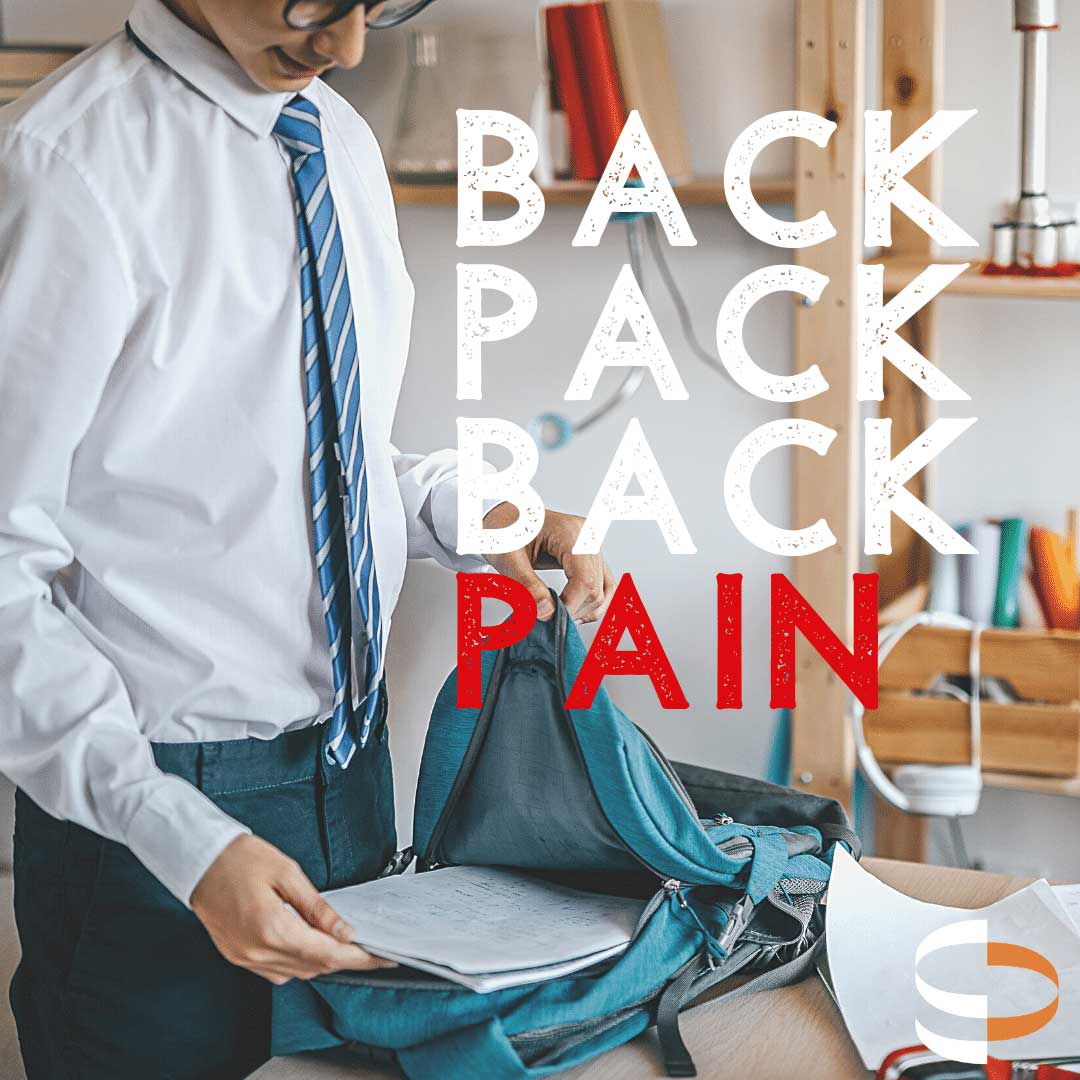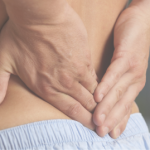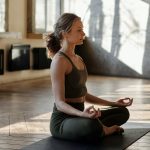Our latest blog talks about all things backpacks!
We’re talking about the different types of bags that you can buy, the different materials, and the different accessories that are available for bags. We’ll walk you through which of these accessories you should be paying more attention to, and which aren’t as important, along with how they will all impact your little one wearing their brand new bag.
Once you have selected the bag, it’s time to get the right fit!! Our blog walks you through everything you need to be aware of when fitting the bag to your child. We also go through the negative impacts of not wearing the bag properly, and what that will mean for back care and back pain in the future.
Back to School BackPain?
Your child’s backpack causing them back pain?
The bag your child’s school bag has many functions and uses throughout the day, but did you ever stop to think about the impact the bag may be having on your child’s back?
There are many things to take into consideration when buying a bag for your little one, and then once you have purchased the right bag – how they should be wearing it, and how everything should be packed away in the bag.
Don’t stress though, this blog is going to run you through what to look for when buying a bag, how to set the bag up to be worn properly, and then how the bag should be packed to avoid any form of back pain.
Purchasing the bag
Buying a bag for your child can be a somewhat daunting experience, there are so many different styles, shapes, types, materials, accessories, and everything else to think about and take into consideration when buying the bag. Here are the main things you should be thinking about when buying the new bag.
Size
A momentary jerk to the side while transferring weight between legs while moving is the most common mechanism. A twinge pain is felt, usually on the outside of the ankle (lateral malleolus), and swelling sometimes follows.
What have I damaged? Most often it’s the ankle ligaments that are partially torn, especially when swelling is visible. On rare occasions the ligament remains intact and pulls at the bone causing a fracture at the attachment site, however, this often requires a greater force. If the bone is particularly tender, or you’re having inner ankle pain, or even pain through the foot (potentially a sprained foot) then a trip to your health professional may help with further diagnosis.
Materials
Not all bags are created equal. The material that you choose for the bag is going to have an impact on the life of the bag, the functionality of the bag, and the overall load capacity for the bag.
There are two main things to consider when choosing the bag’s material; weight, & water-resistance. Canvas materials are lighter than leather, however, generally they are more susceptible to water. If your child is on the smaller side, you may want to consider just going for canvas as the weight of the bag itself can be quite an issue when it comes to loading the bag.
If you’re able to, go for a canvas bag with a weather-proof cover that goes with it. This is the best way to get the lighter material, while maintaining water-resistance at the same time.
Features
When you’re looking at backpacks, the amount of accessories and features for each backpack can be a little overwhelming. There is everything from different types of frame, through to expandable storage!
We’re going to go through some of the key features that you should put a little more weight behind, and then go through some of the features that are more like, “nice to have” features.
Key Features
- Molded frame. The frame is the basic structure of the bag. It’s not something that can be generally seen from the outside, but once you look at a molded frame vs a frame-less bag, you will be able to tell the difference. A molded frame means the underlying structure of the bag is molded to suit a spine, and not just a flat piece of plastic holding everything together.
- Padded/breathable frame. Having the frame padded, adds more padding to the area in-contact with your child’s back. Having a padded frame will definitely add to your child’s comfort. Along with this, you will also find some frames that have ventilated back panels (usually cut-aways in the backing). The added benefit to the ventilated back panel is the excess heat from carrying the bag has somewhere to go. Is this perfect, definitely not, but I definitely prefer having some form of ventilation to having nothing at all and ending up with a very sweaty back!
- Adjustable straps. Most backpacks, surprisingly not all, have some form of adjustment to the straps. Most bags have the ability to adjust the length of the strap, while some bags also have what are called “load lifter” straps. Load lifter straps are straps with the ability to adjust the position of the bag in relation to the top of the shoulders. Generally, these types of straps are only found on top of the line bags, or hiking bags.
- Accessory straps. We’re talking about chest straps, and/or waist straps. While not absolutely essential, they are handy straps for bags that are going to be loaded quite heavily, as they allow the weight to be more evenly distributed across either the chest/shoulders or the hips.
Extra Features
- Multiple pockets. While having multiple pockets in a bag may seem like a very simple and straightforward thing, you may find a large disparity in the amount of organisational pockets within different bags. Multiple pockets (and types of pockets) can help with load organisation and distribution. A bag with one large open storage area may seem like a nice and simple way to pack things, it may make it quite difficult to keep track of smaller objects. Some bags even have specific pockets for certain items, for example, pen holding pockets just for pens.
- External pockets. Most, if not all bags have external pockets. What we’re wanting to talk about specifically here is a pocket designed for a water bottle. Having a pocket specifically for a water bottle on the outside of the bag will help prevent damage from accidental spills or bottle leakage.
- Quick access pockets. A quick-access pocket is used for exactly what it sounds like, accessing things quickly! Generally, these pockets are only very small pockets at the top or side of the bag, used to store things like a mobile phone, or transportation cards. Their great pockets, as having to carry too many things in your pockets can mean some things fall out. Having this pocket still gives you the same speed of access as a pocket, but with more security.
- Security pockets. A security or secure pocket is not necessarily a pocket with a lock on it or anything like that, it is generally a pocket that is difficult for outside people to access. For example, one of the best secure pocket positions is on the back of the back padding (ie, behind your child’s back). This means the only way to get access to this pocket, is to take the bag off and fully turn it around. These types of pockets are generally seen on travel bags, but if you find one on a bag you think will be suitable for school, it can come in very handy.
- Accessory pockets. I know, how many different types of pockets can there be on a bag?! Well, as someone who loves looking at different types of bags, and has several different work bags for different occasions at work I can tell you…there are hundreds!! When talking about an accessory pocket in this circumstance, I’m talking about a pocket that is actually a part of the strap. Now this may be in the form of having a nice wide strap and the pocket is inbuilt, or having a narrower strap, and the pocket is attached to the outside of the strap. These straps are generally only big enough to hold a transport card, but that’s exactly what they are supposed to be used for, and that is what makes them great!! The difference between this pocket and a quick access pocket is that your child doesn’t have to take the bag off to have access to the card, making it that little bit easier and safer.
- Laptop/Tablet protection. It may have been a little while since I was at school, but I know that most children now are doing their learning, least in part, on a computer or tablet. This means they need to be able to transport the device safely, without the risk of damage. Unfortunately, not all “laptop” bags are created equal. Some have better protection than others. The protection that is most important for a school bag is the “drop protection”. This is the protection for the device at the bottom of the bag, usually built into the frame of the bag. One of two things will be the case for drop protection, the sleeve where the device sits will be elevated away from the bottom of the bag, or the bottom of the bag (especially the corners) will have some built-in protection. Either way is great, not having anything is placing the device and your wallet at risk of damage!
- Cinch straps. While not necessary on backpacks generally, they come in very handy if your child is carrying around large, bulky items. These straps are used to help compress the load, squash, to help bring the centre of gravity of the load closer to your child’s back, easing their carry.
How to wear the bag properly
Now you have chosen the right backpack, in the right size & material, with your desired accessories, it’s time to fit it properly!
To fit the bag is actually a very simple process, provided you have purchased the right sized bag in the first place. The bag should sit high up on the shoulders, but still be comfortable. It should sit high enough that the bag finishes at the top of the hip bones, and doesn’t sit on the lower back. You may need to adjust the strap tension if when walking the bag is swinging from side to side.
If you only get one thing from this blog, please let it be this.
Do NOT let your child sling the bag over one shoulder only!!
Having the bag sitting over only one shoulder, even when being swapped regularly, will cause an uneven (asymmetrical) load through the neck, back (upper and lower), and shoulders. This asymmetrical loading can cause pain and irritation throughout the entire spine, usually culminating in lower right back pain or lower left back pain. Along with the lower back pain, the pull on one shoulder could be bad enough to cause neurological symptoms (pins, needles, numbness) down the arm the bag is sitting on.
The other poor way to wear the bag is having it sit too low on their back. While having it sit low makes it easier to get on and off, it actually causes strain all the way up the spine. If the bag is sitting low on the back, in order to counterbalance the weight your child will have to lean forward at the neck and shoulders. This can lead to middle back pain, & neck pain, along with rounded shoulders and shoulder pain.
Loading the bag
The first thing to think about when loading the bag that is going on your child’s back, is the amount of weight being put into the bag. As a general rule the bag should not exceed more than 10% of your child’s body weight! That means, if your child only weighs 40kg, their bag should not weigh more than 4kg!! Lockers can help in this situation, as when your child gets to school they can unload some of things from their bag, however, you should try and avoid overloading their bag whenever possible. Too much load in the bag can cause excessive fatigue of the muscle in your little one’s back, leading to them waking up with lower back pain or stiffness.
Once you have worked out the load amount, and the position of the bag, placing the load in the bag is the next step.The easiest way to think about how to load the bag is to have the heaviest items as close to your child’s back as possible. Meaning having the laptop or text book against the back back of the bag, and gradually getting lighter to only having smaller things on the outside, furthest away from their back. Loading the bag this way can help ensure your little one doesn’t end up straining their spinal muscles, causing lower back tightness, and leading to lower back stiffness.
The other thing to think about when loading the bag is the movement of the objects once they’re in the bag and being transported. Things in the bag should not be sliding around. When items are sliding around in the bag they can cause your child’s centre of gravity to move with it, throwing them off balance. This loss of balance may cause their back muscles to over-activate leading to a back spasm and potentially a lower back injury that requires more focused back care.
What now?
Every now and then, even if you follow all these suggestions to the letter, your little one will end up with some pain in their back or shoulders. That is okay. Usually this occurs when your child is changing year group, and there is a sudden bump in the amount of gear they need to be transporting and they’re not yet used to it.
If your little scholar is coming home from school everyday and telling you they’re having pain through their shoulders, neck, or back, it is best to get them assessed by a professional. In these types of situations the best person to assess what the underlying causes of your child’s pain are, is a Physiotherapist. They have expert knowledge of ergonomics, load management & back muscle anatomy, pain reduction techniques & lower back stretches, along with being experts in injury prevention!
The team at Leaders Sports & Spine Physiotherapy have a wealth of experience in injury prevention and management, especially in growing athletes and scholars!






